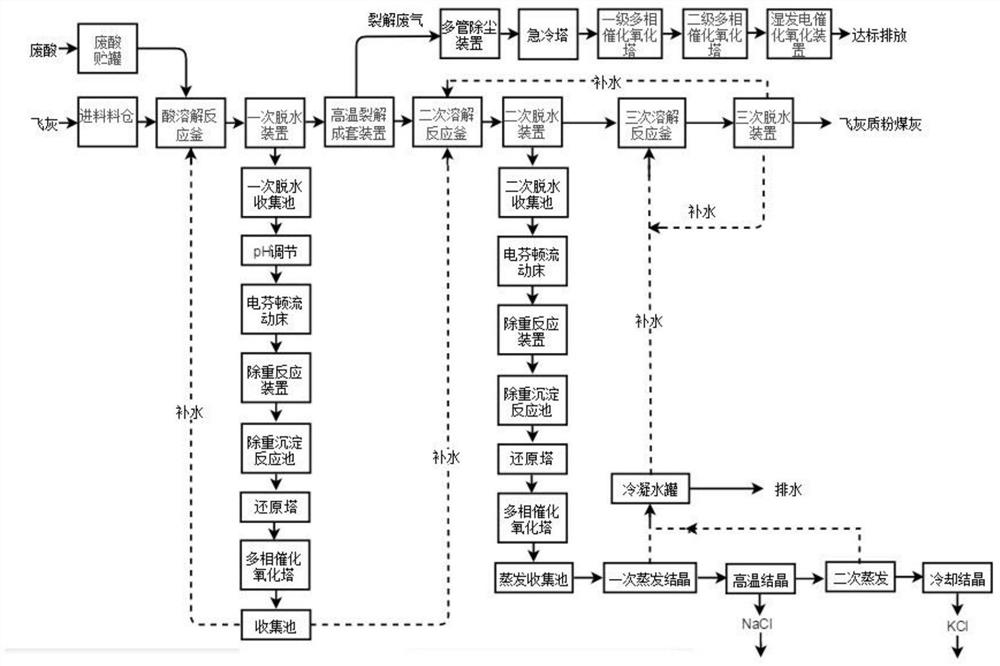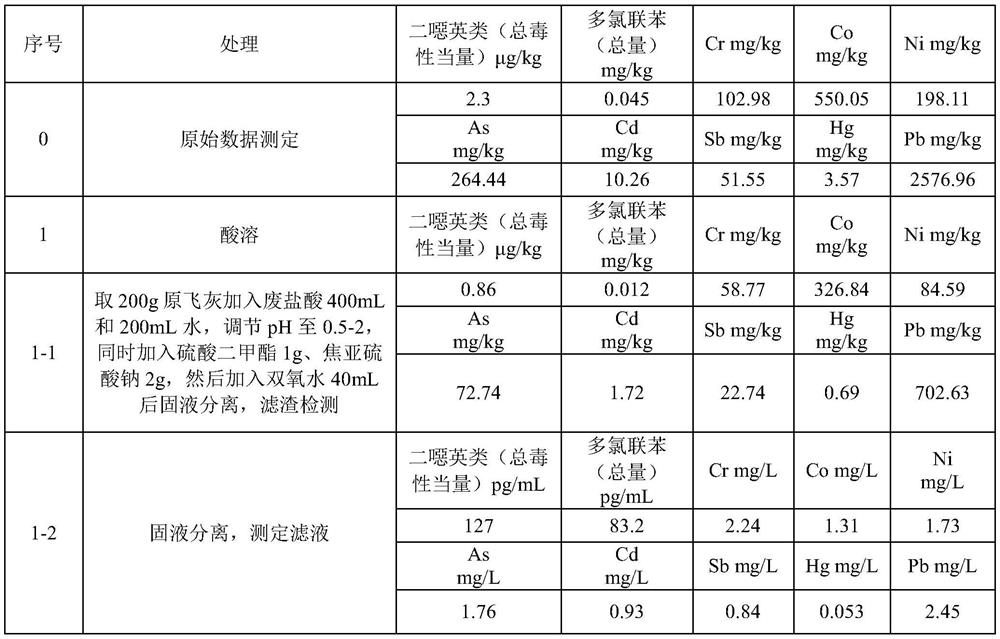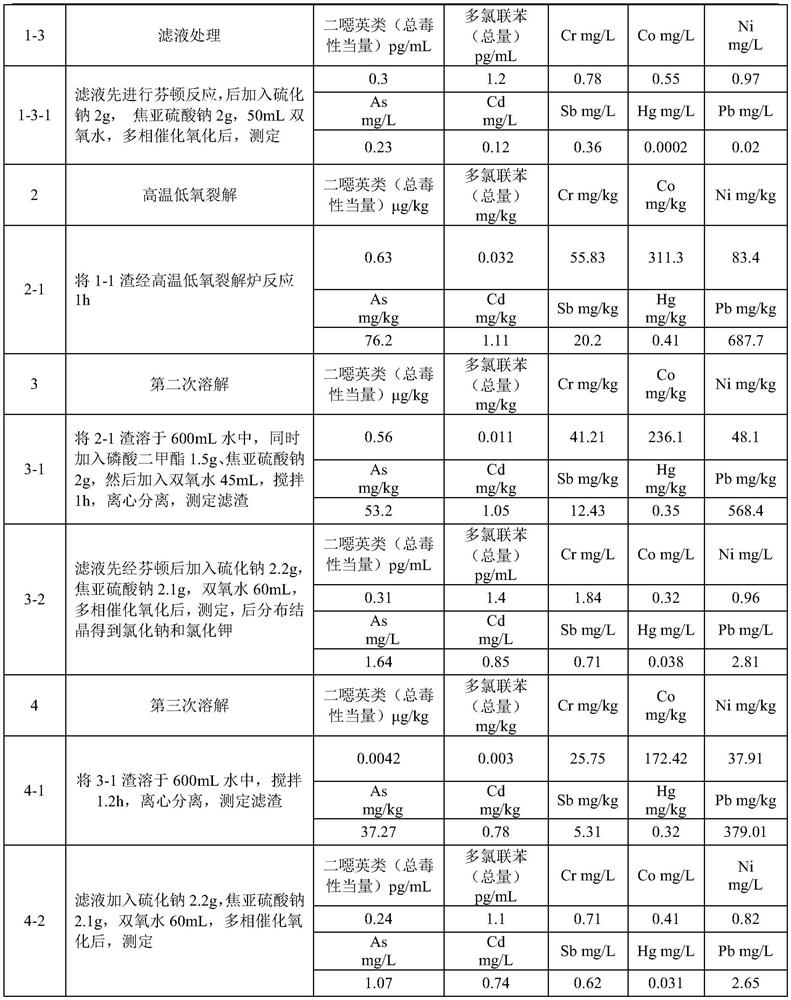Co-processing technology of waste acid in the process of refining fly ash from domestic waste incineration
A technology of domestic waste incineration and co-processing, which is applied in the fields of oxidized water/sewage treatment, special compound water treatment, neutralized water/sewage treatment, etc. Achieve dual resource utilization, save water and cost, and reduce the amount of water added
- Summary
- Abstract
- Description
- Claims
- Application Information
AI Technical Summary
Problems solved by technology
Method used
Image
Examples
Embodiment 1
[0040] (1) Add acid solution, water, solubilizer, flocculant and reducing agent to fly ash for dissolution and stirring, then add oxidant for secondary stirring, and finally separate solid and liquid. Calculated by mass when dissolving, add 1 part of fly ash to 2-3 parts of acid solution, and add 1-2 parts of water at the same time, the mass fraction of the acid solution is 10-20%; the stirring time for two times is 0.5h-2h; The acid used is industrial waste acids such as hydrochloric acid, nitric acid, sulfuric acid, etc., and the pH value of the acid solution is 0.5-2; the solubilizer is a kind of substance that is insoluble in water and easily soluble in dioxins, preferably dimethyl phosphate and dimethyl carbonate Any one of esters, dimethyl sulfate, and acetone, the amount added is 1%-3% of the entire solution mass; the flocculant is aluminum chloride, the amount used is 0.5%-1.5% of the entire solution mass, and the reducing agent includes but not limited to For reducing...
Embodiment 2
[0049] The fly ash in the experiment comes from a thermal power company in Shanghai. It is a typical fly ash produced by household waste incineration. It contains a lot of dioxins, heavy metals and salts, which is very harmful to the environment and human body. The waste acid comes from waste hydrochloric acid produced by a chemical plant, with a mass fraction of about 15%. The present invention can use waste acid to dissolve fly ash, and then remove heavy metals, dioxins and salts in fly ash through different processes, as shown in Table 1-1. And isolate the sodium chloride salt shown in Table 1-2 and the potassium chloride salt shown in Table 1-3.
[0050] Table 1-1 Experimental steps and experimental results
[0051]
[0052]
[0053] It can be seen from Table 1-1 that after dissolving the original fly ash, adjusting the pH value, adding a reducing agent, stirring for 1.5 hours, adding an oxidizing agent and continuing to stir for 1 hour, the dioxin-like toxic equiva...
Embodiment 3
[0061] The fly ash in the experiment comes from a waste incineration plant in Jiangsu, which is a typical fly ash produced by the incineration of domestic waste. The content of dioxin, heavy metal and salt is very high, which is very harmful to the surrounding environment and human body. The waste acid comes from the waste sulfuric acid produced by a dyestuff factory with a concentration of about 16%. The present invention can utilize waste acid to dissolve fly ash, and then remove heavy metals, dioxins and salts in fly ash through different processes, as shown in Table 2-1, and separate sodium chloride salt shown in Table 2-2 and chloride Potassium salts are shown in Table 2-3.
[0062] Table 2-1 Experimental steps and experimental results
[0063]
[0064]
[0065]
[0066] It can be seen from Table 2-1 that after dissolving the original fly ash, adjusting the pH value, adding a reducing agent, stirring for 1.8 hours, adding an oxidizing agent and continuing to sti...
PUM
| Property | Measurement | Unit |
|---|---|---|
| quality score | aaaaa | aaaaa |
Abstract
Description
Claims
Application Information
 Login to View More
Login to View More - R&D
- Intellectual Property
- Life Sciences
- Materials
- Tech Scout
- Unparalleled Data Quality
- Higher Quality Content
- 60% Fewer Hallucinations
Browse by: Latest US Patents, China's latest patents, Technical Efficacy Thesaurus, Application Domain, Technology Topic, Popular Technical Reports.
© 2025 PatSnap. All rights reserved.Legal|Privacy policy|Modern Slavery Act Transparency Statement|Sitemap|About US| Contact US: help@patsnap.com



